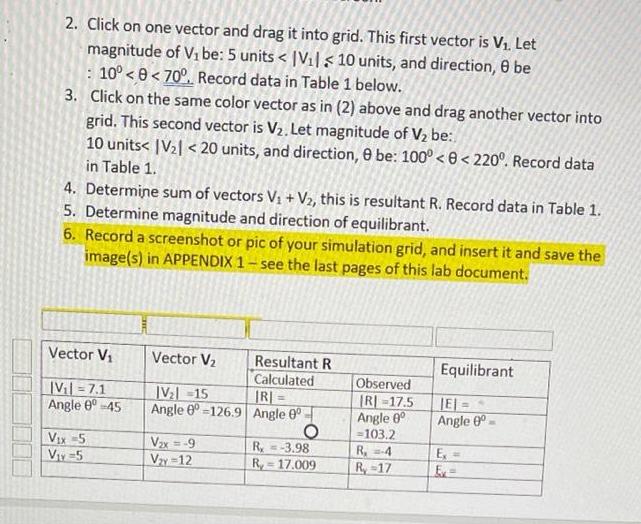Question
2. Click on one vector and drag it into grid. This first vector is V. Let magnitude of V be: 5 units < |V|
2. Click on one vector and drag it into grid. This first vector is V. Let magnitude of V be: 5 units < |V| 10 units, and direction, 8 be : 10 < < 70. Record data in Table 1 below. 3. Click on the same color vector as in (2) above and drag another vector into grid. This second vector is V. Let magnitude of V be: 10 units < |V| < 20 units, and direction, be: 100 <0 <220. Record data in Table 1. 4. Determine sum of vectors V + V, this is resultant R. Record data in Table 1. 5. Determine magnitude and direction of equilibrant. 6. Record a screenshot or pic of your simulation grid, and insert it and save the image(s) in APPENDIX 1-see the last pages of this lab document. Vector V IV|=7.1 Angle 8 45 Vx 5 VV=5 Vector V |V|=15 Angle 80-126.9 Vx = -9 Vy=12 Resultant R Calculated IRI= Angle 0 R-3.981 R, 17.009 Observed IRI-17.5 Angle 8 -103.2 R =-4 R-17 Equilibrant JE = Angle Ex = Ex=
Step by Step Solution
5.00 Ratings (1 Votes)
There are 3 Steps involved in it
Step: 1

Get Instant Access with AI-Powered Solutions
See step-by-step solutions with expert insights and AI powered tools for academic success
Step: 2

Step: 3

Ace Your Homework with AI
Get the answers you need in no time with our AI-driven, step-by-step assistance
Get Started




